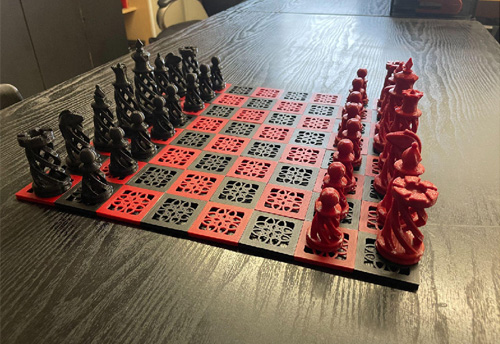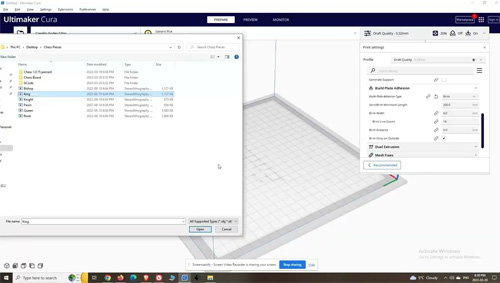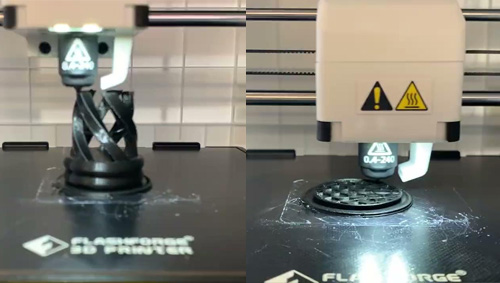The hero of this article story is the Byron Southwood Public School. Located in the vibrant city of London, Ontario, Byron Southwood Public School is always insisting innovative learning conception. “Approximately five years ago, we made the strategic decision to integrate STEM (Science, Technology, Engineering, Mathematics) into our curriculum, and 3D printing became a important part of this transformation.”
Byron Southwood recognized that the modern world is being profoundly shaped by the four pillars of STEM and understood the role 3D printing could play in bringing these concepts to life. Equipped with two 3D printers - one stationed in the school library and an Adventurer 3 Pro in the Grade 7 and Grade 8 classroom, Byron Southwood started the 3D printing projects.
Their students have embarked on numerous creative initiatives, one of which was a team-building exercise - they 3D printed and assembled a chess set.
▲3D Printed Chess Set
3D printing a Chess Set as a Class
They sourced spiral chess set designs from the open-source platform - Thingiverse.com that providing an awesome set of spiral chess pieces that came with a matching board. They decided to use their school colours (red and black), and did some basic math to find out how many pieces to print in each color:
Chess pieces: 8 Pawns, 2 Rooks, 2 Bishops, 2 Knights, 1 Queen, 1 King;
Chess board: 2 Corner pieces, 12 edge pieces, 18 centre pieces;
Lock rings (to hold the board together): 123 Rings.
Start 3D printing chess pieces
Byron Southwood did the 3D printing work on Flashforge Adventurer 3 Pro 3D printer. After downloading the model files from Thingiverse, students imported them to the 3D printer slicer software to convert the files to a format that works with the Flashforge 3D printer (This step is called model slicing, an indispensable step before printing on 3D printers).
▲Piece model slicing on slicer software
In total, the pieces took about 20 hours to print, with the board taking about 16 hours to print. Despite there being 123 lock rings required, students were able to print 10 at a time, and they took only about 4 hours in total to print. So, altogether, the entire board was roughly a 40-hour print.
▲3D printing chess pieces
Meeting challenges during 3D printing
The project was not without challenges, providing the students with ample opportunities to exercise their problem-solving skills. The circular lock rings' design was initially flawed, being too tight and causing distortions in the chess pieces. However, the students quickly identified the problem and resolved it by scaling up the design, increasing the ring's width by 10%. This fix worked perfectly to give the pieces a bit more room to separate, and they were able to push the rings into place with a flathead screwdriver.
Overall, the process went very smoothly. The STEM unit teacher said “Overall, I was very happy with the way this chess board turned out. My students had fun taking turns checking on and removing the many prints, Any issues we encountered served as problem-solving lessons for the kids.”
▲3D printed chess pieces
▲Putting the board together with lock rings
Empowering STEM Education: The Role of 3D printers
"Our 3D printing journey has been facilitated by 3D printers". The Flashforge Adventurer 3 Pro has proven to be particularly suited to the classroom environment, thanks to its quiet, enclosed design, which ensures safety while reducing noise distractions. Furthermore, its wifi-enabled feature provides a modern, seamless, and enjoyable printing process for the students.
Also, the popularity of desktop small 3D printers make it possible to infuse 3D printing technology into school STEM curriculum. It has offered practical, hands-on applications of mathematics and design principles. The students have learned to visualize 2D designs in 3D space, calculate dimensions accurately, and manipulate designs digitally before creating physical objects.
Beyond the educational landscape, 3D printing has brought joy and utility to school life. Students have created practical objects like pencil cups, rulers, door stops, pencil grips, and games. These projects have cultivated a sense of achievement and have demonstrated the tangible outcomes of their STEM education.
In conclusion
The integration of 3D printing and STEM concepts into the curriculum at Byron Southwood Public School has been an enriching journey. Flashforge was quite happy to donate an Adventurer 3 Pro to the school and see this school effectively preparing school students for a technologically advanced future. Not only has it sparked creativity and innovation among students, but it has also enhanced the practicality of learning, making education more dynamic, interactive, and engaging, equipping students with the necessary skills to excel in the world beyond the school gates.









